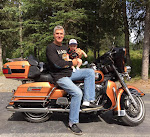We loaded up about 8 kids - not one wearing any sort of rain gear and about the same number of us - all wearing head to toe rain gear. We left town in the driving rain. The clouds lowered over town, dark and heavy with rain and let loose upon us. Nevertheless, we plowed forward to our destination. Frankly I thought it would just be pretty miserable of an outing, but I was very keen to see more of the territory up close.
We powered up river for about 20 minutes and arrived at our spot. The fire was smoldering and we went to work to put up a shelter of sorts - kind of hard when the tallest bush is only about seven feet high and very spindly. Others went to work on the fire and getting more fire wood split. The rest of us hauled up our coolers full of food and the $60 in soda I have already mentioned.
Interestingly enough, as soon as we had everything ready for getting the food out, the sun came out from somewhere between the clouds and flooded our picnic spot with light and warmth. Suddenly everyone was peeling off layers of rain gear and coats. This brightened up the mood considerably. Soon we were roasting "brats" over the smoldering fire and scooping up a meatloaf casserole with our hands as we forgot to bring plates and other civilized utensils to eat with. Since we were hungry it didn't seem to matter a lot to anyone.
We then sang, shared testimonies and prayed. Then in a spontaneous moment, we had a spear throwing contest. The "target" was an empty pickle jar that had just been emptied. Everyone who joined the contest was very intent on being the one to knock the pickle jar off the stump. There was also a search for some of the edible plants in the area and the usual dodging smoke in the eyes around the fire.
After a couple of hours, the sun let us know it wasn't going to stay around any longer so we loaded up the boats and headed off up river to see what could be seen.
The Yukon River at this point is huge. Once we arrived at the main channel of the river, it might as well have been a huge lake as there was nothing but water on the horizon to see. It was amazing to try to comprehend how big a river could be. There are many, many channels that crisscross back and forth through the river. Someone like me was unfamiliar with the area could take a wrong turn and be lost forever. It is certainly a place where people could disappear easily.
We saw a couple of fish wheels, a family of foxes and some really flat land. Just because the river is wide does not mean it is deep everywhere. Way out in the river we hit some very shallow water which you couldn't tell from the surface as it is very muddy and the wind was blowing which put riffles on the water everywhere.
All in all, it was a fun and worthwhile outing. As we neared town, the rain came back as strong as before and we all hustled to get things back to the church and ready to pack up for home the next day.


